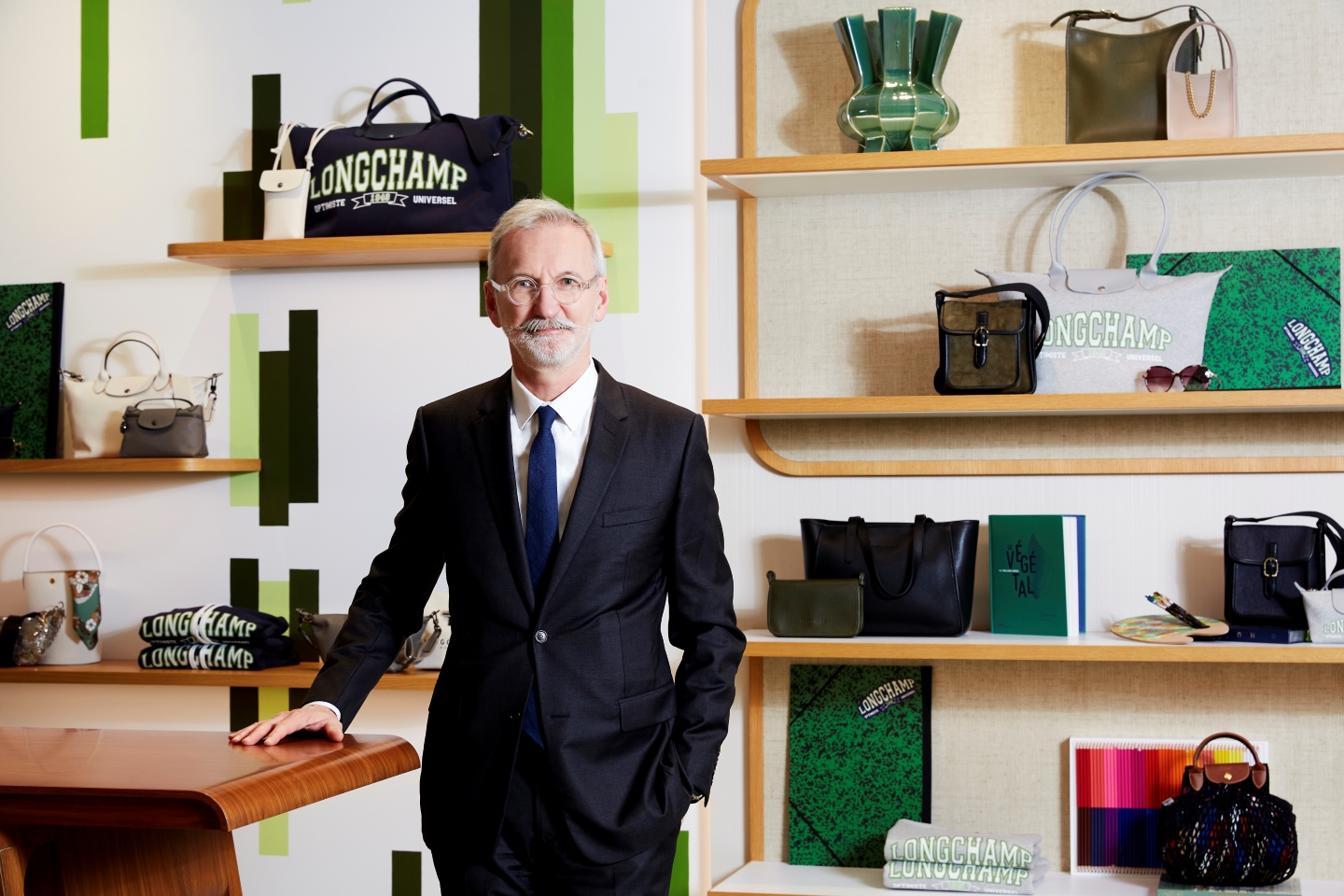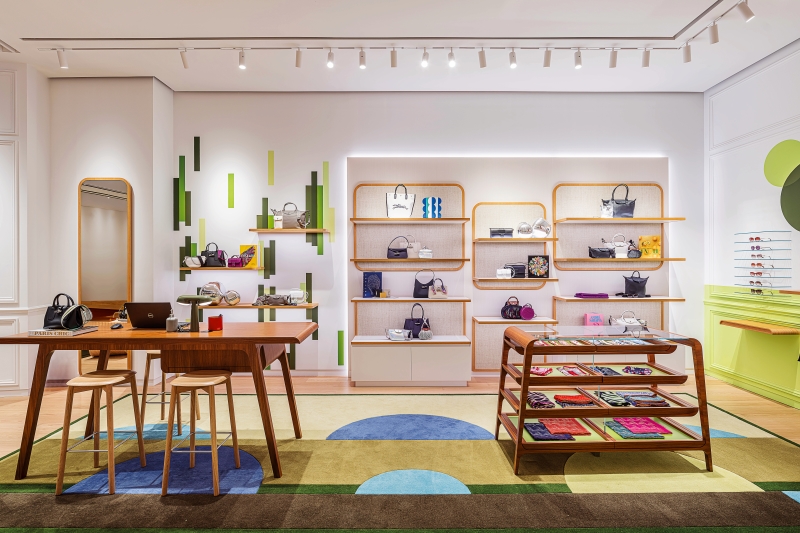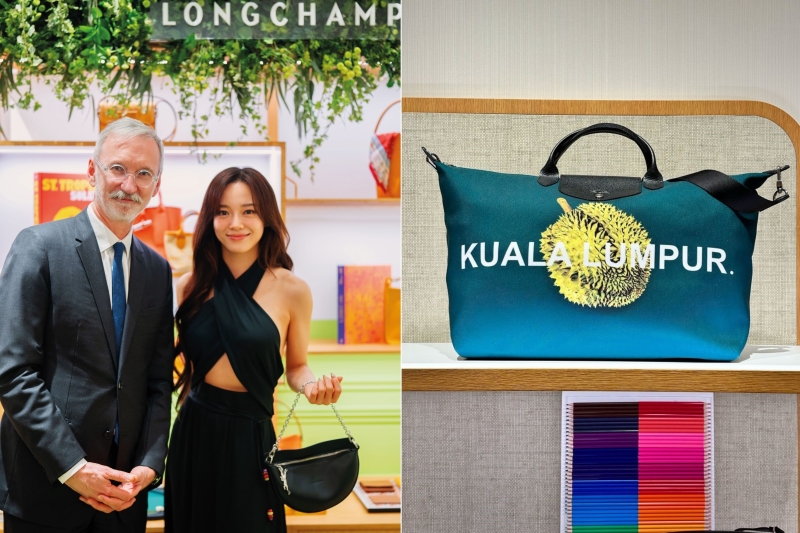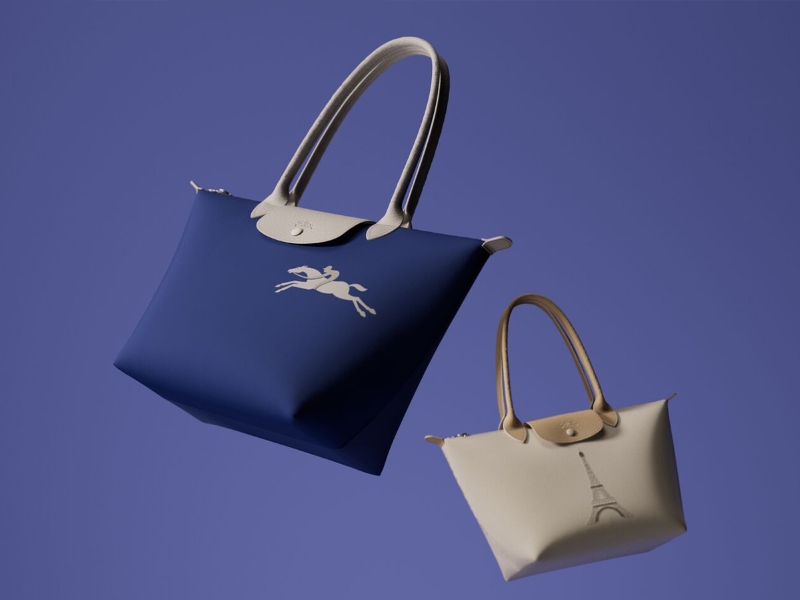
Comfort and welcome are emotions Cassegrain wants to evoke at The Exchange TRX store in Kuala Lumpur (Photo: SooPhye)
Thinking long term is Longchamp’s style. When the pandemic triggered the scramble to adopt e-commerce, the French leather goods company paused to reconsider the role of physical stores. “You know, people can shop online very easily and the internet is always going to be more efficient. If consumers take the trouble to come to the store, it means they want more than just convenience or efficiency — they are looking for an experience. They’re not only coming to buy a product; they’re here to spend some nice moments.
“During Covid, we were rethinking. We want our store to be very welcoming so customers will have a good time while shopping. They can sit and stay as long as they want, check their email, read the books. It’s like being in a friend’s home,” says Longchamp president Jean Cassegrain, who was at the Feb 3 opening of its largest boutique in Malaysia.
“At the same time, the store is a way to express the brand’s image. It is our ‘embassy’ here. It is colourful, warm, friendly and happy. It also has a Parisian touch. The idea is to feel like you’re in a nice apartment in Paris.”
Comfort and welcome are emotions Cassegrain wants to evoke at The Exchange TRX store in Kuala Lumpur. “Shoppers must feel like they have walked into a friendly home, an atmosphere we really want to create. This is a fairly new shop design concept that we’re implementing. It’s the first time we’re doing it on a large scale, like [the outlet in TRX].”
Longchamp recently renovated its outlet in The Gardens Mall, KL. Work on other locations will follow the same concept but each will have something unique that differentiates it. At TRX, it is the lemon-lime wall. There is even a travel bag with a durian motif! Elsewhere, it could be the furniture, carpets or artwork, making the stores the same but slightly different.
But there will always be the bold, vibrant colours this Paris-based maison built on innovation and quality is known for. And, as it has done over the decades, fresh hues are constantly being added to the palette.
“We have 10 or 12 new shades every season. Colour is part of the brand identity,” Cassegrain says, pointing to Le Pliage — “folding” in French — its iconic folding bag first launched in 1993. Lightweight, durable, relevant and versatile, “Le Pliage bags have conquered every generation, in every continent. Their simplicity and elegance make them universal”.
bag_and_accessories.jpg

Longchamp, founded in 1948 by Cassegrain’s grandfather (after whom he is named), has been owned and run by the family since, “reinventing the French art of living every season”.
The first product grandpa Jean made was a leather-covered pipe. He then renamed his company Longchamp (or long field), after a famous Paris racecourse next to an old mill he passed by during his daily rides. The association between both is that his surname — cass-grain literally means “seed-breaker” — brings to mind a miller, and his collections are designed for the world of saddlery.
“Horse racing is a combination of sport and elegance. I think the idea of sporty elegance appealed to my grandfather.”
In 1971, Cassegrain’s father, Philippe, designed his first bag for women and launched the Longchamp Leather Goods line. In 1988, the maison opened its first flagship store at 390 rue Saint-Honoré, the famed shopping street, an address chosen by the latter’s wife, Michèle.
Today, the brand has handbags, small leather goods, eyewear, luggage and travel accessories, footwear and ready-to-wear that are sold through a network of more than 400 exclusive boutiques worldwide.
"Malaysia is becoming quite a significant market, as are Singapore, Indonesia and Thailand. This is a very dynamic region where we are established and doing quite well and we’re very much pushing for it,” notes Cassegrain who, as part of his national service, spent a year at the French Trade Commission in New York assisting French companies aiming to establish a foothold in the US.
From his infrequent visits to Malaysia, he notices that women here enjoy shopping, and colours. “They’re good customers for us. And they like the lightweight pieces. But they also like our leather items. We have a collection called Pliage Extra; the leather version of these bags is quite popular. ”
Colour is one thing Cassegrain has in common with those in step with what’s on trend. “Yes, I do like colour. Of course, today I am working ... But I use some very colourful bags.”
In 2023, Longchamp’s sales reportedly hit a new record, up 44% from the previous year. It saw remarkable growth in China (up 84%), where seven new stores were opened. But the Covid years were “tough on us, quite a shock”, Cassegrain recalls. But being financially sound, the company bounced back and business has picked up strongly since. Ultimately, the pandemic had a positive effect because “it pushed us to make some changes a little more quickly”.
Yet, there is no dismissing the increasing competition. With trends in a state of flux and more brands beginning to be visible, Cassegrain acknowledges “we have to come up with innovative ideas all the time, whether it’s store design, products or online communications. We need to do a lot to exist and emerge in an environment that is very busy. In the shopping mall, among the many shops, you must stand out.
longchamp_kuala_lumpur.jpg

“Yes, to summarise, how to stand out is probably my No 1 worry today,” he lets on.
Growing up surrounded by leather and exposed to the business from young, did he have his career cut out for him? “Yes, I think I was expected to take charge. I never thought of doing something different.” So he joined Longchamp in 1991.
“The building in Paris where I lived as a child was also a workshop where some products were made. Also, my father was the designer and he always enjoyed sharing new items and ideas with us. We were very much into the business even as kids.”
His mother, who was in a different line of work, was roped into the brand in the 1980s. She developed the store network because Longchamp was more like a manufacturer then, selling its goods to independent shops. Subsequently, she created a retail system that operated under that name.
Cassegrain now helms the company with younger sister Sophie Delafontaine: He manages aspects like manufacturing, retail and expansion while she, as creative director, is responsible for design. Younger brother Olivier, based in New York, handles operations in the US.
Three fourth-generation members have joined the fold: Cassegrain’s sons Adrien and Hector in 2020, and Sophie’s daughter Juliette Poupard, early this year. London-based Hector takes care of the UK market while Adrien works at the HQ as director of transformation, in charge of corporate social responsibility projects especially.
CSR has become important and consumers now expect that a brand they trust will behave in a responsible way. “When they place their confidence in it, they do not want to be disappointed,” says Cassegrain, who was made a Knight of the National Order de la Légion d’Honneur in 2012.
In the past, this confidence or trust was anchored to quality. While that is still important, CSR has become equally so. “If you find that a brand you like is not behaving as it should, you will switch to another one. As such, we must have programmes to ensure we progress and that we’re doing the best we can to be socially positive and contribute to preserving the environment.”
Like using recycled polyester and polyamide to create Le Pliage, bags symbolic of the brand. “In the 1970s, we were among the first to use nylon to make bags and luggage. Leather is long-lasting and has a special natural touch that is impossible to match. We were very much into it but also open-minded about new materials that can be alternative to leather.”
Brands need to adapt and social networks are a good way to reach out, especially to the young, Cassegrain thinks. Every season, the brand comes up with different stories to animate new collections and create a homogeneous message. This season’s story is stitched to the Longchamp University collection, for which Sophie, together with some students, imagined the pieces they would love.
longchamp_recycled_polyester.jpg

Clothing inspired by the fashion culture of the 1970s and a curious, connected Gen Z are steeped in university design codes and student life. The result is creative and unisex lines forming silhouettes that embody femininity, a sportswear vibe or hippy chic. Accessories with timeless colourways bag audacity, adding a touch of whimsy to the collection.
What would he say is Longchamp’s legacy, shaped by generations over 76 years?
“It’s the values of the business or respect for the know-how and the artisans, and the love of leather. Leather is our main material and we love it, we have a passion for it. I think it’s the brand values as expressed through our products — optimism, authenticity, energy, sincerity.”
Helming a family business makes Cassegrain prudent. He also accepts the fact that “when we spend, we don’t always expect immediate returns”. Expenditure could be an investment for the long term, like renovating a store, expanding manufacturing capacity, having new workshops and machinery, or developing and nurturing craftsmanship or training new staff, especially the young, to take over as older ones retire. Besides subcontractors that the company works with, about 800 people are employed in its own factories in western France to produce its bags.
The business offers an international dimension that he appreciates. “What I like is the diversity, adapting to the different cultures and teams, whether it’s people from Malaysia or South Korea, America or Germany.”
On the other hand, what is not always obvious about a luxury business is the work that makes it tick.
“What is visible is the more glamorous part. Underneath, it’s simply work. All the time you’re thinking about how you can do better, and communicate with your siblings and children.”
No, the Cassegrains do not get in each other’s hair because they all have different tasks.
“My brother lives in US and my sister is in product design. I am more on the business side. We don’t step into each other’s territory.”
Where does Longchamp figure among the top French luxury brands?
“That’s an impossible question [to answer]. We have our own spot, our own personality. We’re doing our thing and not trying to compare with others or be someone else. We are what we are and happy to be ourselves, promoting our own identity.”
As for how he would define that identity, Cassegrain says: “It epitomises French flair, is fresh, inspires creativity and shares the active lives of women across the world who enjoy a touch of luxury every day. Under Sophie’s direction, the brand has come to define the Longchamp woman: She is free, independent, Parisian, chic and cosmopolitan.”
Just as clothes can make a woman, the company’s ready-to-wear line, well over a decade in the market, helps to express “the silhouette of the Longchamp person and pass on the message of who she is. It’s someone who has a very active life. She moves around a lot, she does many different things in a day, she’s joyful and positive”.
Is that also the family DNA?
“I think so. I hope so, yes,” he says. The chuckle that follows makes light of his own active routine: A triathlete, Cassegrain runs, cycles and swims thrice weekly and takes part in the annual Deauville Normandy Triathlon. He will be there again come June, to engage in the punishing disciplines, “just for the enjoyment of participating”.
What plans do the younger Cassegrains have for the company?
“I don’t know what they’re planning, really. But, of course, the intention is that we continue as a family business. We want to remain independent because it gives us a lot of freedom and the opportunity to really see long term.
“Sometimes, when companies come on the stock market or become part of larger groups, they are more financially driven. I think we are less so. We are more driven by the brand, its DNA and what we feel is good for it. We are thinking more for the next generation rather than the next quarter.”
Would the team consider bringing outsiders in to be at the helm? “Why not? But that is not the plan at the moment. The subject is not on the table,” he says.
This article first appeared on Feb 26, 2024 in The Edge Malaysia.


